It was a dark and stormy night on the eighth day of Shravan month when Lord Krishna was born. Deep in the prison cells of Mathura, Vasudev and Devaki waited for the birth of their eighth child. Outside, the winds wailed and storm raged through the city. King Kansa, brother of Devaki, had already killed her seven children with his bare hands. Soon the auspicious hour came close. The storm hushed and the night calmed. And at the stroke of midnight, Devaki bound in chains, gave birth to her eighth child, a baby boy i.e. Krishna.
The day marked the occasion of Janmashtami all across India. With great devotion and exhilaration, the day is celebrated to commemorate the birth of Lord Krishna. It is on the eighth day of the month of Shravan according to Hindu calendar, and every year, the celebration period falls somewhere between August and September. This year it falls on the 24th of August.
According to Hindu texts, Lord Krishna came into this world as the eighth avatar of Lord Vishnu and destroyer of the evil on this day. Ancient Hindu literature, including Bhagwat Gita and Bhagavata Purana state the story of Lord Krishna’s birth. Many people treat this day as an occasion to honor the victory of good over evil.
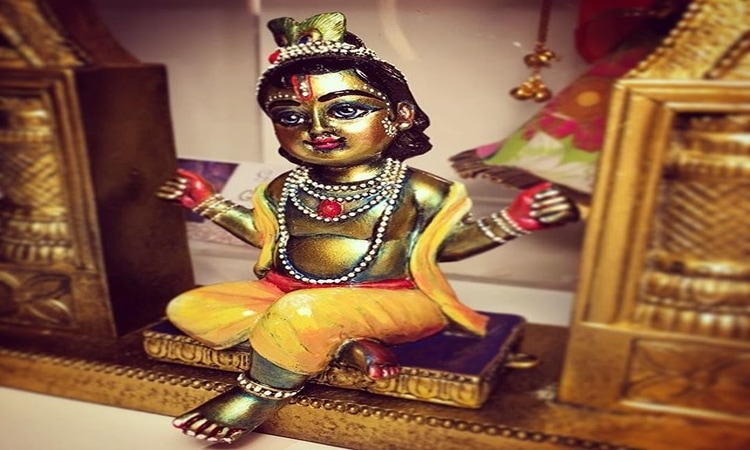
In this article, we’ll be going through how the Janmashtami is celebrated across India. The festival is celebrated all across the country but the festivities in Mathura, Vrindavan, Gujarat and Maharashtra are exceptionally grand. Festivities take place over two days as Krishna was born at midnight. The first day is known as Krishna Ashtami, or Gokul Ashtami, and is usually observed with fasting through the day and breaking it by reciting prayer at midnight after the Lord is born. The second day is called Kaal Ashtami, or Janam Ashtami, which involves recitals, dances, devotional songs, and feasting.
The whole nation comes together to celebrate the day with enthusiasm. Celebrations include people preparing for plays, temples being decorated with flowers. The arrangements of “Janmashtami Jhankis” on different themes relating to the life of Lord Krishna, his childhood, boyhood and other incidents in his life. Though the most important jhanki arrangement is that of baby Krishna. Devotees also make beautiful ‘jhulans’ or cradles for the Bal Gopal.
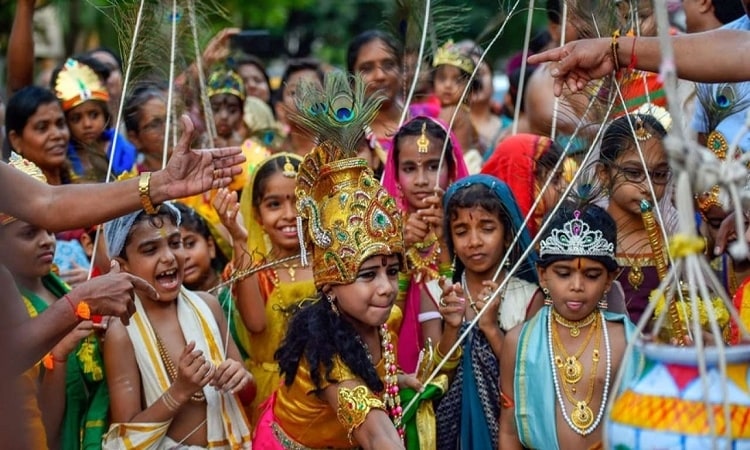
While celebrations throughout the country are enthralling, some places in India deserve a special mention. They are the places that celebrate Janmashtami with true essence. Let’s take a look at the different places where the festival has a special place in the hearts of the people and gets celebrated with a lot of enthusiasm.
Mathura
According to Hindu mythology, Lord Krishna was born to Devaki and Vasudeva in the kingdom of Mathura. So, being the birthplace of Krishna, Mathura is indeed the best place to experience the grandeur of the festival. The city has around 400 temples dedicated to Krishna, all of which get decorated up in a beautiful way. The grand celebration takes place at the Dwarkadhish Temple which is considered one of the oldest and largest temples of the city. Thousands of devotees gather inside the temple for the celebration of Janmashtami at midnight. Inside the temple, Lord Krishna is given the bath with milk & curd and Jhulan Utsav takes place. As soon as the door opens 5 minutes before midnight, the temple complex echoes with the slogan “Jai Kanhaiya Laal Ki”. After the ritualistic prayer finishes, all devotees receive “Panchamrit” and those who keep fast open it with this only.
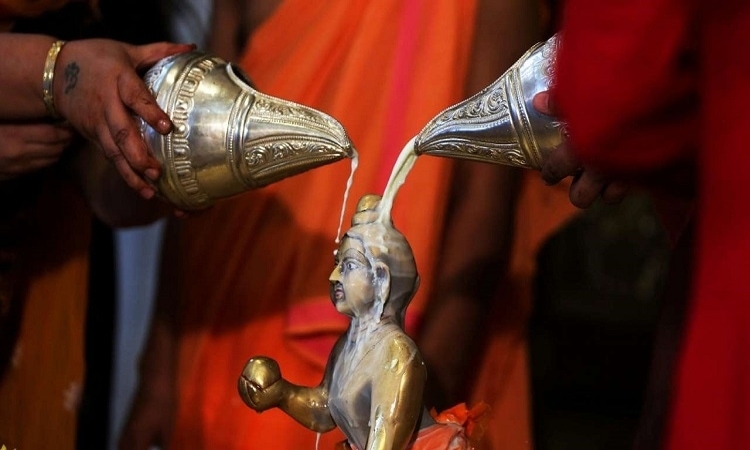
Great celebrations also take place at the Krishna Janma Bhoomi Temple which is considered the actual place where Lord Krishna was born. Temple gets decorated with lights, flower and traditional decorations. Various pandals (tents) are set up and Rasleela performances take place around the city. The idol of Krishna is sanctified with milk, honey and curd during the Abhishek ceremony. The idol is then decorated with new clothes and jewellery and placed in cradle decorated with flowers. Devotees keep chanting prayers in the background.
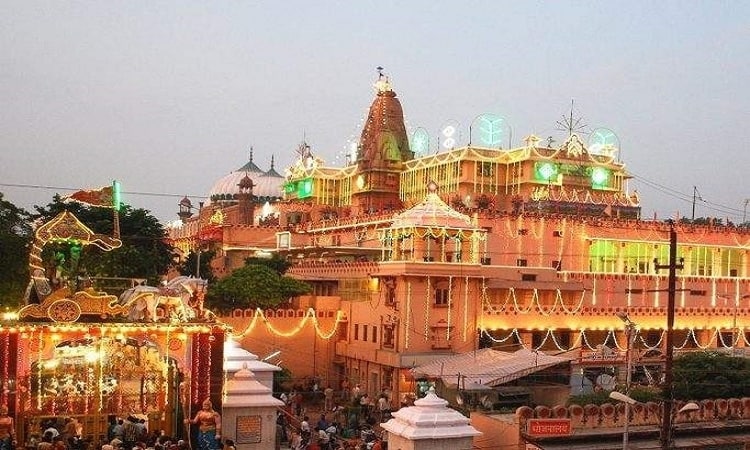
Vrindavan
Vrindavan is the place where Lord Krishna spent significant time in his childhood. So, like Mathura, Vrindavan is one of the places that have mythological importance because of its association with Krishna’s life and celebrates Janmashtami with great zeal. It is the place where Krishna used to do Rasleela with Gopis and this is why various enactments of Rasleela are seen around the city during Janmashtami. In various temples, festive rituals can be witnessed here as well. However, the Banke Bihari Temple is the most sought after place here during the festival. Thousands of devotees arrive here for darshan. The same ritual is practiced here in which the Abhishek takes place at midnight and after the ceremony, devotees are given “Panchamrit” as the holy prasad.
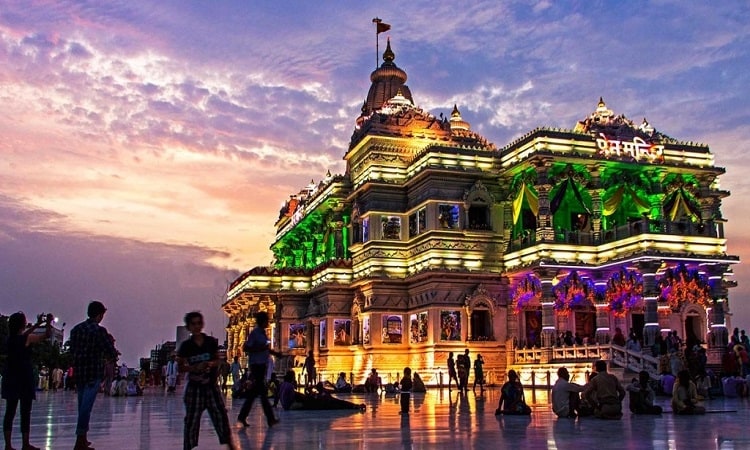
Other than this temple, ISKCON Temple and Sri Krishna Balram Temple also celebrate Krishna’s birthday in a great manner. These temples also attract a huge number of devotees during this festival and make the festival grand by extremely great decorations and ceremonies.
Madhuban in Vrindavan is also a major highlight during this time. It is considered as the place where Krishna participated in Rasleela with Radha and Gopis. The place is serene and filled with spiritual warmth.
Maharashtra
The state of Maharashtra celebrates the festival in its own distinctive way. The cities of Pune and Mumbai have splendid celebrations during the Janmashtami. The day is observed as Gokulashtami here, the highlight of the festival is the Dahi handi ritual, which is a re-enactment of Lord Krishna's love for butter and curd. During childhood, Krishna often used to steal the butter in the same manner and so was given the name – “Makhan Chor”. In this ritual, an earthen pot filled with yogurt, milk, fruits is suspended high in the air and a group of young men called the “Govindas” form a human pyramid in an attempt to break the pot and spill the yogurt as how Krishna used to do in his childhood.
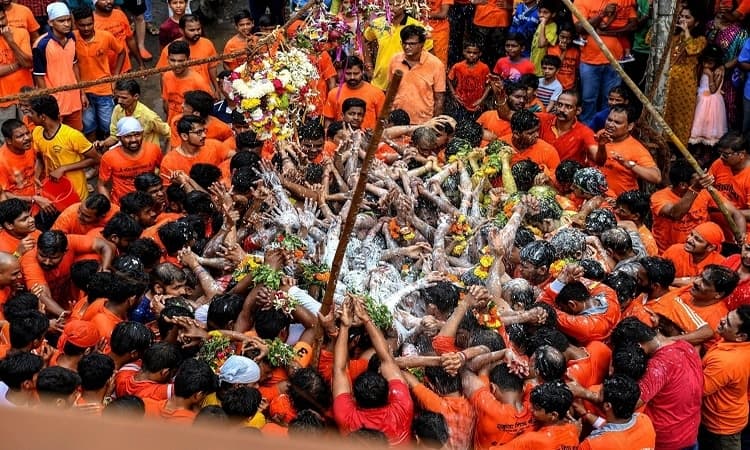
This yoghurt is then offered to everyone as prasad. The Dahi handi ritual takes place at different locations and various competitions are hosted. Winning teams are awarded cash prizes that can go up to hundreds of thousands of rupees based on the sponsors of the event. A Mumbai-based ‘Jai Jawan Govinda Mandal’ from Jogeshwari has also registered its name in the Guinness Book of World Record for making a nine-level human pyramid of with a height of 43.79 feet in the year 2012.
Gujarat
The city of Dwarka in Gujarat also celebrates the festival with great ardour. According to the scriptures, Dwarka was the kingdom of Lord Krishna. The infamous Dwarkadheesh temple is dedicated to the Lord and is one of the holiest temples of India. The city gets a whole new and beautiful look during the festival and is one of the best among the Janmashtami celebrations across the country.
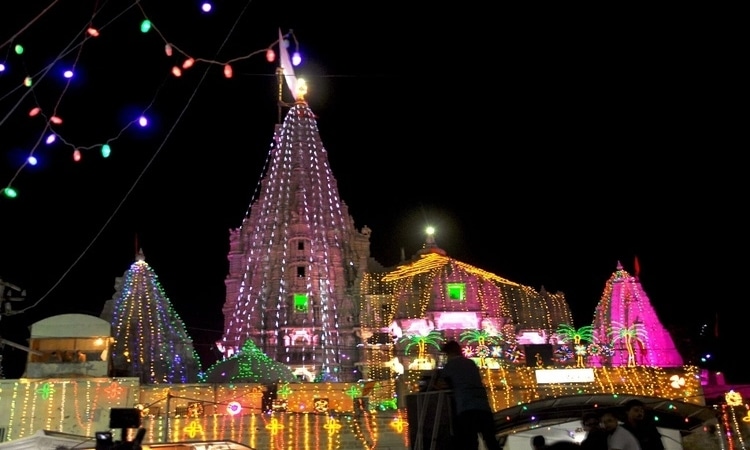
There is also a ritual here similar to that of Dahi Handi of Maharashtra, except here it is known as Makhan Handi. Night-long celebrations take place including a Garba dance, Rasleela performances also happen across the city.
The temple gets decorated aesthetically and attracts a huge crowd on the day of Janmashtami. Rows of lights brighten up the place, which brings out the festive spirit all the more. Lord Dwarkadeesh is adorned with precious jewelry of gold, diamonds, etc. The Mangal Aarti performed in the morning here is also worth attending as a part of the celebration. Also, there is a sea beside the temple which itself makes the temple more aesthetic.
Odisha
The holy town of Puri is famous for the Jagannath Temple has its own set of celebrations which are special to the region. It is one of the few temples which houses a wood-carved statue of the lord, as opposed to the stone ones found elsewhere. The celebrations of the birth of Krishna are performed in full swing here. The deities inside the Jagannath temple, Lord Jagannath and siblings Balrama and Subhadra are dressed in special clothes on the festive day. Thousands of devotees visit the temple on the day of the festival.
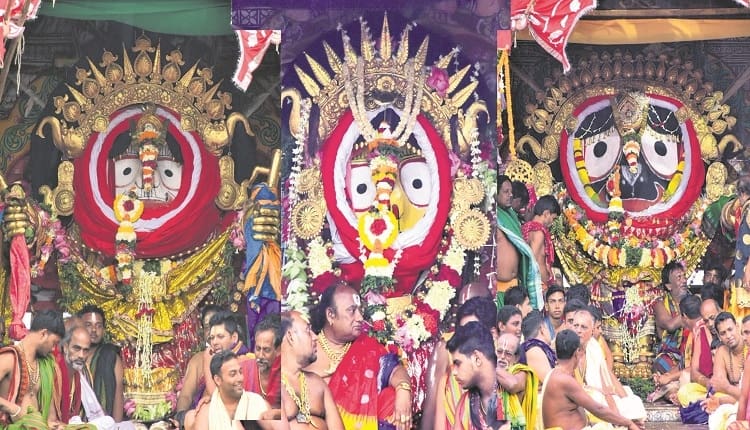
Chronicles of Lord Krishna and Balaram are enacted every evening. They begin with Krishna's birth, with one episode being performed each day by communities in the city. Episodes that stand out in Krishna’s life like the tale of Bakasura badha and the legend of Kalia dalana where he killed a multi-headed snake are performed. The festivities go on for 17 days from Janmashtami and end with the enactment of Kansa vadh which portrays the death of Kansa.
South India
South India also gets festive during the Janmashtami. The celebrations, however, differ from those in the north. In Tamil Nadu, people draw beautiful decorative patterns called “Kolam”, made with rice batter on the floor, and footprints of Krishna at the entrance of their house.
South India also gets festive during the Janmashtami. The celebrations, however, differ from those in the north. In Tamil Nadu, people draw beautiful decorative patterns called “Kolam”, made with rice batter on the floor, and footprints of Krishna at the entrance of their house.
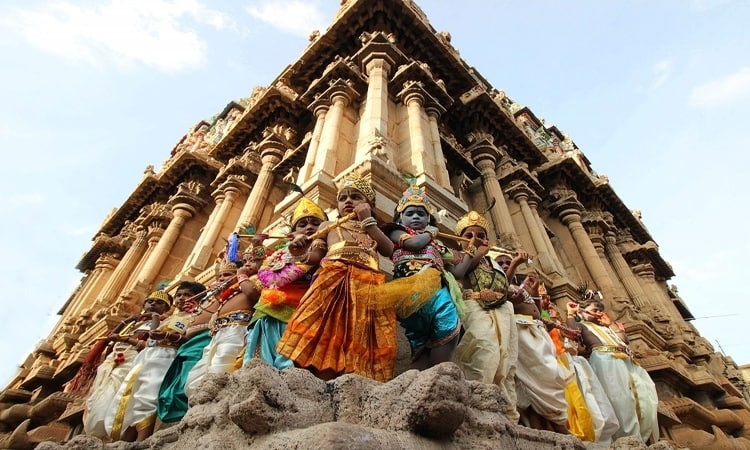
In Karnataka, the Krishna Janma Mahotsav Samiti of Kadri holds special Krishnashtami celebrations every year. In Udupi, the birth of Krishna is celebrated with special regional tones. Street performers add to the atmosphere. Plays portraying episodes from Krishna’s childhood life are held, besides singing and dancing late into the night. It is believed that the Sri Krishna Matha at Udupi came into existence after the city of Dwarka submerged.
In Kerala, the Janmashtami is celebrated at Guruvayur temple where the procession of a golden idol of ‘Balkrishna’ is accompanied by the temple’s elephants. This takes place all along with classical dance and music performances.
Manipur
Janmashtami in the city of Imphal, Manipur witnesses huge crowd of devotees at the Sri Govindajee temple unlike the other festivals of North India that aren’t as famous in this part of the country. People observe fast and visit the temple offering floral tribute to Lord Krishna. Folk dance performances are a major part of Janmashtami festivities in Manipur.
The Hindus in Imphal are ardent followers of Lord Krishna, and their devotion is seen in their delightful celebrations. Various activities like recitation of scriptures, the Rasleela dance and visits to the famous ISKCON and other Krishna temples occur here during the occasion of Janmashtami.
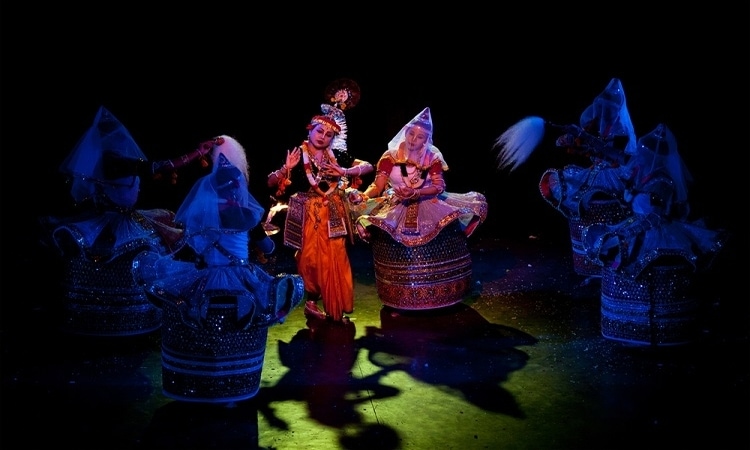
In the recent past, the Hindus in the state faced some economic blockade, with some Christian sects continuously placing hurdles in the celebration of different Sanatani rituals but nothing was able to keep the Hindus away from celebrating the birth of Lord Krishna.
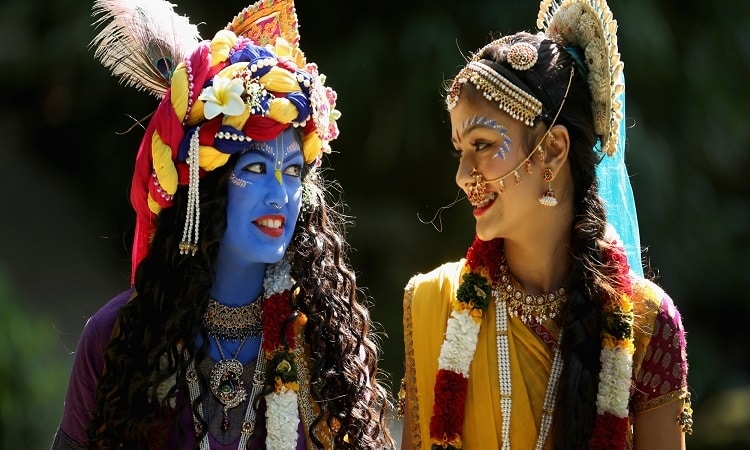
In addition to India, the festival of Janmashtami is celebrated in Nepal, Bangladesh, Pakistan, Fiji, Trinidad and Tobago, Guyana, Singapore and some parts in the USA.
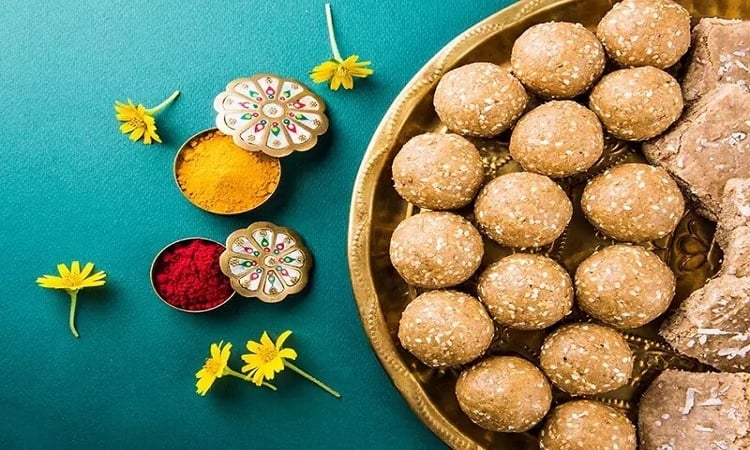
The monsoon of India is tied with myriad festivals and among them comes the festival of Janmashtami which itself is one of the most significant Hindu festivals. Almost every Hindu household decorate and keep little idols of baby Krishna in the temple of the house. Most of the people even fast on the day and break their fast at midnight (the time which is believed Krishna was born). Some people also prepare the special 'Chappan Bhog' to please the deity. Once Krishna, had to lift mount Govardhan under which the people of Vrindavan took refuse to save themselves from the extreme rains sent across by angry Lord Indra. He stood their lifting the mountain on his little finger for eight days straight. Once the rain subsided, women of the village treated him with a special bhog consisting 56 kinds of food.
So, celebrate this Janmashtami in a special way and prepare different kinds of prasads and sweets. Trainman wishes you all a very Happy Janmashtami!! Book your tickets through Trainman app. Download Trainman App and check PNR Status of the booked ticket, Seat Availability, Train Running Status, Train between Stations and lot more.

